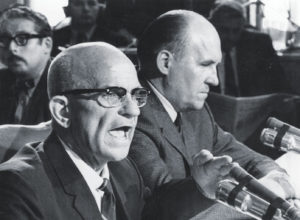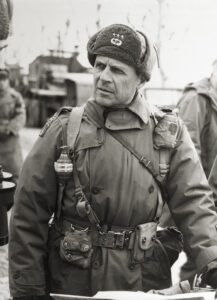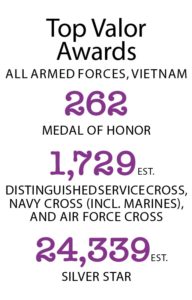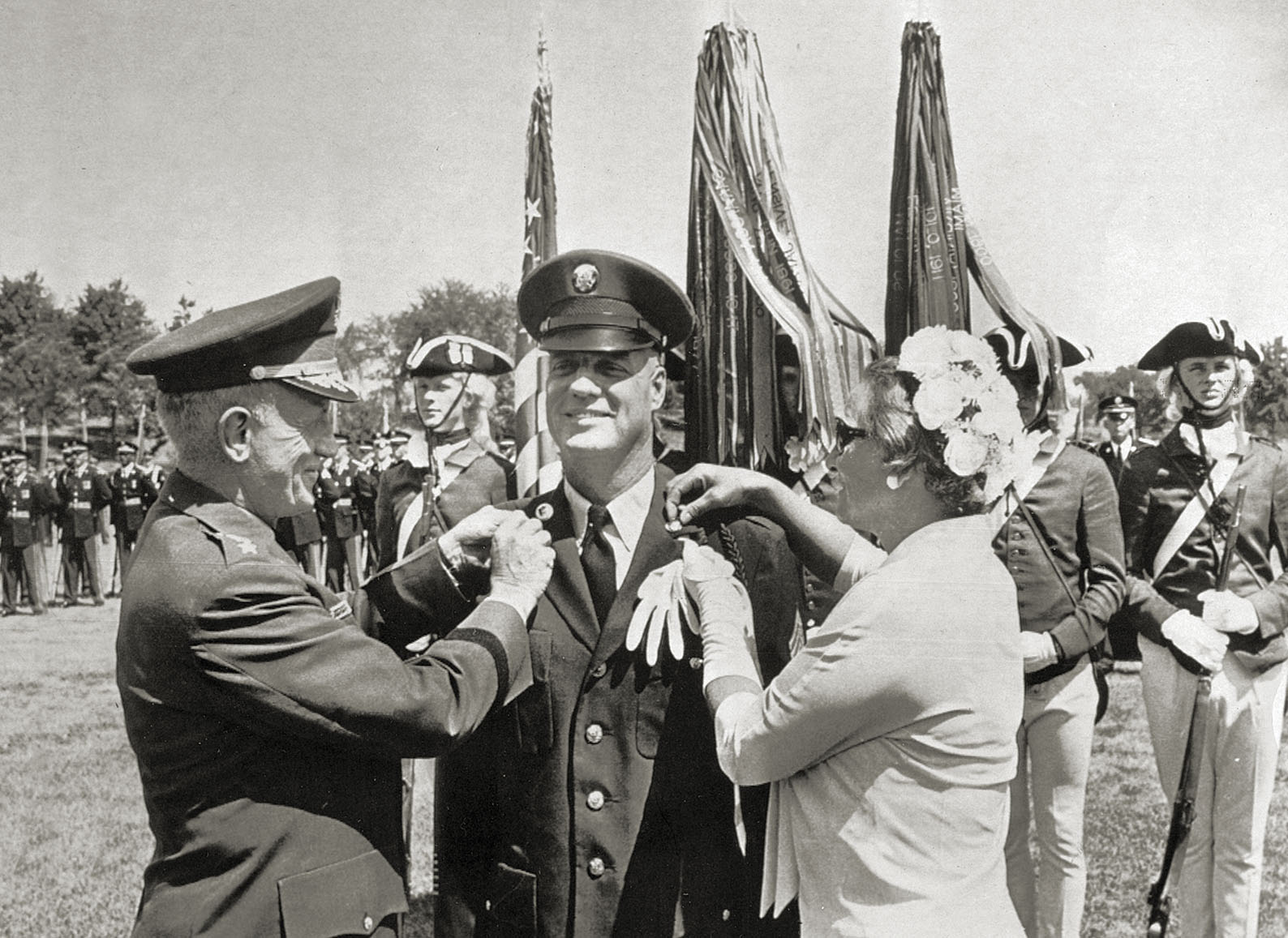“Not before in my lifetime—and I was born into the Army in the nineteenth century—has the Army’s public image suffered so many grievous blows and fallen to such low esteem in such wide areas of our society,” began an op-ed piece in The New York Times on April 2, 1971, by retired four-star Gen. Matthew B. Ridgwa
Ridgway—born March 3, 1895, at Fort Monroe, Virginia, as the son of an artillery colonel—continued: “This is of national relevance, though it portrays but one of many manifestations of the spiritual malaise presently pervading all levels of our people, and for the first time, to my knowledge, all armed forces ranks.”
The essay, titled “The Ordeal of the Army,” was published just days after the longest court-martial in U.S. military history (more than four months) concluded at Fort Benning, Georgia. On March 29, 1971, 1st Lt. William L. Calley Jr. was convicted by a court-martial of the premeditated murder of 22 South Vietnamese civilians in 1968 in the village of My Lai.
Two days later, Calley was sentenced to life imprisonment and hard labor at the U.S. Disciplinary Barracks at Fort Leavenworth, Kansas. The sentence was reduced on appeal by Secretary of the Army Howard H. Callaway and President Richard Nixon.
The Calley case was just one of the stains on the Army’s reputation that distressed Ridgway. “The denigration of the Army’s Sergeant Major, his indictment, and that of several other senior noncommissioned officers by a Federal grand jury on charges of embezzlement of N.C.O funds overseas; the award of battlefield decorations for acts never performed; the pending charges against the former Provost Marshal General of the Army; and most damaging of all, the Mylai court-martial, are grievous blows.”
Ridgway’s reference to “pending charges against the former Provost Marshal General of the Army” the Army’s top military police official, alluded to the alleged crimes of retired Maj. Gen. Carl C. Turner, then under indictment in the U.S. District Court in Alexandria, Virginia.

Exactly a week after the publication of Ridgway’s op-ed piece, Turner pleaded guilty to the unlawful solicitation of 136 firearms from the Chicago Police Department for his personal use. The government charged that Turner had misrepresented the weapons as gifts to the federal government.
Turner acknowledged in 1969 U.S. Senate hearings that he had received nearly 700 weapons, turned half over to the Army, repaired others for museum display and sold at least 23 to a gun dealer in North Carolina. Additionally, Turner was charged with four counts of tax evasion, which asserted that he and his wife failed to declare almost $50,000 in income over a four-year period. The general was forced to retire from the Army in 1969.
Turner was also implicated in improprieties and graft in the Army’s Vietnam NCO clubs, another scandal referenced in Ridgway’s op-ed. Sgt. Maj. William O. Wooldridge, at one time the Army’s senior noncommissioned officer, was charged with participating in a scheme that involved three other noncoms.
Wooldridge admitted under oath that he had intervened to block the investigation of three sergeants in Vietnam who were accused of black-market currency violations. All four pleaded guilty to criminal fraud or conspiracy charges, which included skimming slot machine money, kickbacks from suppliers to the clubs and favors to higher ranking officers so they would look the other way.

Two years after Ridgway’s op-ed, a Senate subcommittee in 1973 looked at allegations that Turner had hindered the investigation of the NCO clubs. Wooldridge told the senators: “The nature of the military establishment does not permit thorough, independent investigation of alleged wrongdoing. As long as you have generals and sergeants major too, there’s going to be influence used in certain areas.”
One NCO involved in the scandal, Sgt. William Higdon, explained in his testimony: “You always take care of the general, the sergeant major, the base commander or whoever it might be.” Sgt. Seymour Lazar, responding to a question from subcommittee Chairman Sen. Henry M. “Scoop” Jackson of Washington, stated that corruption and graft of this nature had “been going on since 1776.”
Wooldridge, in a signed sworn statement, alleged that retired Maj. Gen. William A. Cunningham III, had deliberately chosen to overlook club management “improprieties” brought to his attention while commanding the 24th Infantry Division in Germany in 1965.
The four NCOs had refused to answer questions when they originally came before the Senate subcommittee in 1969. They subsequently pleaded guilty to criminal fraud or conspiracy charges and agreed to tell the subcommittee about the scandal and its cover-up. Turner and Wooldridge were stripped of their Distinguished Service Medal awards in September 1969.
Ridgway’s complaint about “battlefield decorations for acts never performed” was rooted in the military’s morale problems in Vietnam as American troops fought in an increasingly unpopular war. Ridgway, a commander in World War II and Korea, had earned two awards of the Distinguished Service Cross, four awards of the Distinguished Service Medal, two awards of the Silver Star, two awards of the Bronze Star Medal with a “V” device for valor, a Purple Heart and the Combat Infantryman Badge, almost never awarded to a general while serving in that rank. In Vietnam, as Ridgway saw it, a grade creep had infiltrated the Army’s system to award medals for valor and meritorious service while in combat.

Ridgway probably would have had little quarrel with the Army’s Vietnam Medal of Honor awards, 174 presented to date, for conspicuous gallantry and intrepidity above and beyond the call of duty. Each Medal of Honor recommendation was thoroughly vetted, underwent the most intense scrutiny and had eyewitness testimony.
The Distinguished Service Cross, the second-highest decoration for valor, was awarded to just over 1,000 U.S. Army soldiers in Vietnam, according to the Home of Heroes website. Several recipients of the Distinguished Service Cross in Vietnam went on to become three- and four-star-generals.
The Silver Star for gallantry in action is perhaps where Ridgway began to find fault with the Army’s award criteria. A total of 21,634 Silver Stars were awarded to U.S. Army personnel in Vietnam, according to Home of Heroes. Many of them went to commissioned officers.
Some units allegedly had a standard “awards package” for battalion and company commanders upon completion of their normal six-month command tours. The package included a Silver Star, one or more Bronze Stars and possibly Air Medals, in addition to the Combat Infantryman Badge. Few enlisted men, even high-ranking NCOs, received such an “awards package” at the end of their tours.
A 1978 book Crisis in Command: Mismanagement in the Army, by two former Army officers, Maj. Richard A. Gabriel and Lt. Col. Paul L. Savage, excoriated the Army leadership on multiple fronts, with particular aim at the service’s awards and decoration practices during the Vietnam War.
The co-authors, who taught in the Politics Department at St. Anselm’s College in Manchester, New Hampshire, state: “A study of the available data concerning the number and type of medals awarded relative to both combat activity and actual casualties taken suggest that as the frequency and intensity of enemy contact declined, the number of awards, many for bravery, actually increased at an astonishing rate.” The study they cite is retired Col. William L. Hauser’s 1973 book, America’s Army in Crisis.
“So blatant was the practice of awarding medals for actions that were at best marginal in terms of risk,” Gabriel and Savage say, “that even officers began to refer to these awards and medals in derisive terms. They called them ‘gongs.’ Still, they continued to award them to one another and, more importantly, to accept them.”
The authors claim that “some unit commanders used the number of awards for bravery that a unit had been given as part of a complex formula to measure the combat effectiveness of the unit.” This is a reference to a statistical system developed by Maj. Gen. (later Lt. Gen.) Julian J. Ewell, who commanded the 9th Infantry Division in Vietnam and later II Field Force, which oversaw units in the Saigon area and Mekong Delta. Ewell may have been influenced by Defense Secretary Robert S. McNamara’s statistically minded bean counters in the Pentagon. The authors say Ewell’s system was derided by many officers, including Gen. Creighton Abrams, the top commander at Military Assistance Command, Vietnam 1968-72.
Gabriel and Savage also make this bold statement: “Virtually every soldier who managed to survive his tour was given a Bronze Star [for meritorious service]; if he had seen any combat whatsoever, the tendency was to award him a ‘V’ device to go with it. The Combat Infantryman’s [sic] Badge, once the symbol of service and hazard that separated the true combat veteran from the ‘garret trooper,’ was debased so as to encounter derision from all the troops.”
That particular assertion, however, is easily disproved with statistics. About 2.6 million U.S. military personnel served in Vietnam during the main ground combat period, Jan. 1, 1965, to March 31, 1973, according to Defense Department records. About two-thirds were Army personnel. An estimated 1.6 million fought in combat, provided close support or were regularly exposed to enemy attack.
If “virtually every soldier” was given a Bronze Star, the medal would have been awarded to something like 1 million men. In truth, about 35,000 Bronze Stars went to Army soldiers for their Vietnam service, according to the National Archives. Those honors consisted primarily of 26,215 awards for meritorious service in the combat zone, 2,159 for achievement and 6,215 awards of the Bronze Star with a “V” device.
Summing up their analysis of the Vietnam War awards system, Gabriel and Savage conclude: “In the end, the award system designed to stimulate the morale of the troops undermined it. It became a standing joke. More important, however, was the fact that officers usually participated in the system with relish, swelling their personnel files with reports of their own bravery and thus increasing their chances for promotion. The troops were rarely fooled.”
It surprises no one that “medal inflation” became a key component of Vietnam service. Given the opportunity to command a battalion or rifle company for a normal six-month tenure, officers were well aware that an outstanding efficiency report, together with a Silver Star, Bronze Star with “V” device and an Air Medal or two would go a long way toward favorable consideration by the next promotion board.
The controversy over medal inflation didn’t end with the Vietnam War. It was also visible in Iraq and Afghanistan. NBC News reported in 2004 that the U.S. Air Force had “handed out” more than 69,000 awards and other honors for the Iraq War, followed by the Army with “40,000 medals issued and approved, including 111 Silver Stars and more than 13,000 Bronze Stars.”
The year 1971 was a time of anguish for Ridgway not only on a professional level but also a deeply personal one. On July 1, his only son, Matthew “Matty” Ridgway Jr., a newly commissioned 22-year-old second lieutenant from Bucknell University’s ROTC program, was struck and killed by a train while portaging a canoe over his head alongside a railroad track in Ontario. The general and his wife flew over the Lake of the Woods in Canada where Matty died and scattered his ashes into the serene waters.
Ridgway died at 98 on July 26, 1993. He is buried in Arlington National Cemetery. V
Bob Orkand, a retired lieutenant colonel, served in Vietnam as executive officer and operations officer of the 1st Battalion (Airmobile), 7th Cavalry, 1st Cavalry Division (Airmobile) 1967-68. He commanded a mechanized infantry battalion at Fort Benning in the 197th Infantry Brigade 1972-73, a prototype of the volunteer Army. In 1974, he was Pentagon spokesman on the volunteer Army. He co-authored a study of the M16 rifle’s shortcomings, Misfire: The Tragic Failure of the M16 in Vietnam (2019). Orkand lives in Huntsville, Texas.
This article appeared in the April 2021 issue of Vietnam magazine. For more stories from Vietnam magazine, subscribe here and visit us on Facebook:





